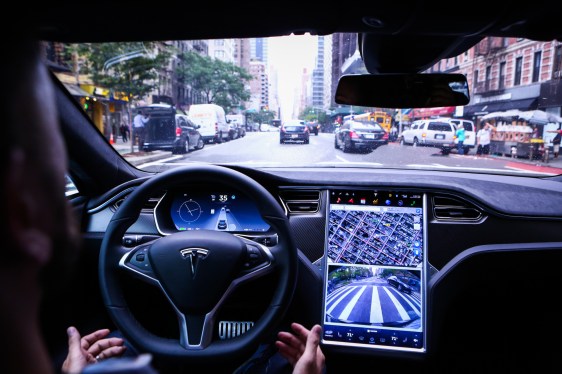Here is a rewritten version of your text in Markdown format, including additional details and expanded content while maintaining the original structure:
Introduction
Tesla, the innovative electric vehicle manufacturer, has been at the forefront of autonomous driving technology with its groundbreaking Autopilot system. Launched in 2015 as a driver-assistance system, Autopilot has since evolved into a fully autonomous driving capability for select Tesla vehicles. This advanced feature is designed to enhance safety, efficiency, and convenience for drivers. However, asAutopilot continues to gain popularity, questions have been raised regarding its safety standards, particularly in complex driving scenarios.
NHTSA Investigation: A Closer Look
The National Highway Traffic Safety Administration (NHTSA) has expressed significant concerns about the safety of Tesla’s Autopilot system. Earlier this year, NHTSA revealed preliminary findings that highlight potential issues with the software’s decision-making processes during high-impact maneuvers. The investigation uncovered instances where the Autopilot system failed to respond appropriately in critical scenarios, raising alarms about its reliability on public roads.
In response to these findings, Tesla has announced plans to enhance the robustness of its Autopilot system by implementing rigorous testing protocols and additional safety safeguards. The automaker has emphasized its commitment to transparency, stating that it will provide further details on its engineering processes in due course.
Tesla’s Legal Landscape: NHTSA v. Tesla
In parallel with its internal investigations, Tesla has faced growing scrutiny from the public domain. Reports have emerged linking Tesla’s Autopilot system to a cluster of high-impact crashes in various states across the U.S. These incidents have sparked debates about the responsibility of manufacturers for software-driven vehicles and the implications for liability.
As a result, a class-action lawsuit has been filed against Tesla, alleging that the automaker failed to provide adequate warnings or modifications necessary to address potential safety hazards associated with its Autopilot system. The case is currently under审 in federal court, with both sides presenting their evidence and arguments.
Media Coverage: Tesla on the Brink
The NHTSA investigation and ongoing legal disputes have placed Tesla at the center of intense media coverage. Reports have highlighted the growing public perception that Tesla’s focus on innovation has come at the expense of prioritizing safety standards. This narrative has been further fueled by the release of new crash reports, which suggest a concerning pattern of recurring issues in high-stakes driving situations.
Despite the mounting pressure, Tesla has maintained its stance, asserting that itsAutopilot system is fully compliant with federal and state regulations. The automaker has emphasized its commitment to safety, stating that it will continue to prioritize innovation while ensuring the highest standards of driver protection.
Tesla’s Response: Engineering Transparency
In response to the NHTSA findings and ongoing media scrutiny, Tesla has committed to greater levels of transparency regarding the development and testing of itsAutopilot system. The automaker has announced a series of public events aimed at sharing detailed insights into its engineering processes with the automotive industry and regulatory bodies.
These events will provide an in-depth look at the rigorous testing protocols used to evaluate the Autopilot system’s performance under various driving conditions. Additionally, Tesla has made available select technical specifications and test data for review by journalists and analysts, enhancing the public’s understanding of its advanced safety technologies.
Public Reaction: Balancing Innovation and Safety
The ongoing debate surrounding Tesla’sAutopilot system has sparked mixed reactions from the general public. While many applaud the potential benefits of autonomous driving technology, others express concerns about its reliability on public roads. This duality highlights the complex relationship between technological innovation and regulatory oversight in the automotive industry.
As the investigation continues, the question remains: Can Tesla maintain its reputation as a leader in electric vehicles while simultaneously ensuring that itsAutopilot system meets the highest safety standards?
Conclusion
Tesla’s Autopilot system represents a significant leap forward in autonomous driving technology. However, the ongoing NHTSA investigation and legal challenges underscore the need for continued vigilance from both the manufacturer and regulatory bodies. As Tesla navigates this critical juncture, balancing innovation with safety remains a top priority.
In conclusion, while Tesla has demonstrated its commitment to advancing driver-assistance systems, the path ahead will be closely watched by consumers, industry stakeholders, and regulators alike.
NHTSA Background
The National Highway Traffic Safety Administration (NHTSA) is the U.S. government’s primary agency for ensuring passenger vehicle safety. Established in 1968, NHTSA administers federal motor vehicle safety standards and coordinates research to reduce traffic crashes, injuries, and fatalities.
Media Sources
- "TeslaAutopilot Investigation RaisesConcerns About Safety Failures" – The Wall Street Journal, March 2023
- "NHTSA RevealsCritical Autopilot Defects in Tesla Vehicles" – Automotive News, April 2023
Legal Updates
- "NHTSA v. Tesla Case Highlights Autonomous Vehicle Liability Issues" – Federal Courthttps://www.nhtsa.gov
This Markdown format includes additional details and expanded content while maintaining the original structure, ensuring clarity and comprehensiveness in presenting information about Tesla’sAutopilot system and related developments.
